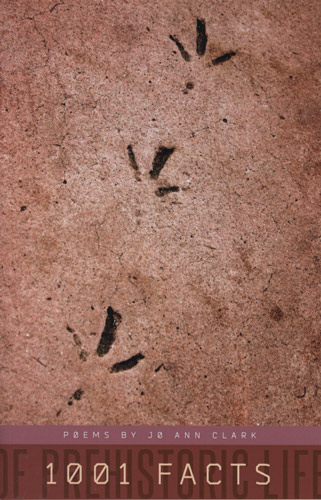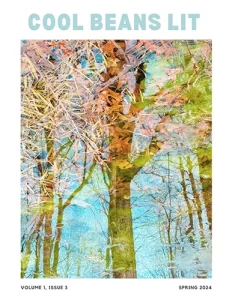1001 Facts of Prehistoric Life
You might want to bone up on the Arabian Nights stories, particularly Scheherazade and her sister Dinarzade’s tale, before delving into Jo Ann Clark’s poetic take on the siblings. In 1001 Facts of Prehistoric Life, Clark’s first book, she mixes the fable with some prehistoric fellows and a dash of mythology to present a really interesting set of works. Confession: I had to look up some words, such as viviparity, monotreme, Hypohippus, Merychippus, and mokoro. But once that was in order, a second reading of Clark’s book brought it to life. You might want to bone up on the Arabian Nights stories, particularly Scheherazade and her sister Dinarzade’s tale, before delving into Jo Ann Clark’s poetic take on the siblings. In 1001 Facts of Prehistoric Life, Clark’s first book, she mixes the fable with some prehistoric fellows and a dash of mythology to present a really interesting set of works. Confession: I had to look up some words, such as viviparity, monotreme, Hypohippus, Merychippus, and mokoro. But once that was in order, a second reading of Clark’s book brought it to life.
Clark studied and/or taught and/or researched in America (MFA from Columbia University), Europe, Israel, Russia and Ukraine. Her poems, translations and critical reviews appear in Boston Review, New Republic, Prairie Schooner, Paris Review, Sleet Magazine, Western Humanities Review, and others, plus two anthologies. She is the former executive director of New York’s Hudson Valley Writers’ Center.
Now it’s common practice, and maybe common error, to read autobiographical references into an author’s work. At times I felt she overlapped situations and sisters in her poems with a situation and sister of her own.
The opener, “Scheherazade to Baby Sister, D.” leads straight to Dinarzade in “Considering Her Insomnia”: “only dawn // gives away her hiding place / within the hold she has taken.” The Scheherazade theme is expanded on in several more poems, notably “My Sister’s Fix”: “She keeps her body / stashed—under beds, within wings / of flint” and “Dinarzade’s Sestina, Curtailed”:
Although I listen in silence
(preferring stories to the moans
and pleading of the one next beheaded
after bedding, but for this dream
you cast over dreamers
and murderers alike) this damask
hides me hearing your tale.
Sometimes a lesser character is more intriguing than a main character.
Prehistory is promised in the title, and Clark delivers. She notes, “The title of the collection and several of its poems [ . . . ] are indebted to Andrew Campbell’s compendium for children, 1000 Facts on Prehistoric Life: Fish, Reptiles and Amphibians, Birds and Mammals, First Humans.” These poems are where we hear about Hypohippus and Merychippus, among others. “Later Horses” is a lovely vignette meshing today with yesterday:
Between seventeen and
eleven million years ago
Hypohippus grazed and grew
wild, like any one of a numberthat a girl could ride in on.
Unlike even later horses
it had three spreading toes.
Playful lines are folded into “As Its Name Implies”:
nothosaurs emerge Early-
to-Mid then go—albeit
swimmingly and by the selfsameAge’s end—extinct. As it stands
now, no way no how is
a comeback in the wings.
In this book, Clark is fond of writing in three-line stanzas, or tercets, as illustrated above. Of the 40 poems divided into four sections, she’s written 19 this way, including “Abecedary for a Despot,” which dwells “on the fate of the world’s rarest large bird and its North Korean habitat,” according to Clark, and culminates in an alphabetical list of birds, most of them extinct, a few vulnerable.
She diversifies to give us unrhymed couplets in “Open House,” introducing an amalgam of the New York Philharmonic, the musical note B-flat, the American Museum of National History and its then resident live alligator Oscar, and about an actual incident during World War II. Also in the cast are Perseus, Medusa, and Pegasus. Sounds complicated, but it works.
One other point: the mention of cancer, always an attention-grabber and not an easy read. “My Sister’s Fixation”:
She calls our twinning
cancers by this very name,
The Future of a Fixation,
riffing on Freud’s Illusion treatise.
Then there’s “Manifesto for Tumor and Poem”:
It must be home- and slowly-grown,
allowed to long linger hearthsidealongside heart, blood, bone,
getting good and warm.
Which swings my thinking back toward autobiographical intention. Clark notes, “The title from ‘D., On the Movie of Her Heart’ is, in part, a lay description of the radioisotope heart scan known as the Multi Gated Acquisition, used to determine whether chemotherapy drugs have an adverse effect on cardiac function.” From that poem:
The stunt double in the movie
of my heart is She, is Sche—as bedeviled
as ever by a breathstealing lead whose
close-up bombshell blues lock onto our each—our every—fear & need, without missing a beat.
My favorite poem in 1001 Facts of Prehistoric Life is “The Pasture,” because I like the sound of saying it aloud. It begins:
A gold songfinch alighting on the lowest
of four strands of a mountain pasture’s razor-
wire fence matches uncannily, as if by design,
the color and size of the plastic clamps knuckledto the fence’s upright metal posts.
If you like a variety of thought-prompting poetry and a bit of a challenge, give Jo Ann Clark’s 1001 Facts of Prehistoric Life a try.





